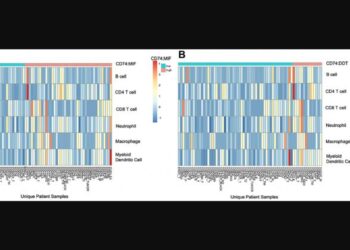Risk-adjusted screening strategies for prostate cancer should help to ensure that fewer men are tested unnecessarily often. According to the experts, this can reduce over-diagnosis and over-treatment, which can cause more harm than good.
Risk-adjusted screening strategies for prostate cancer should help to ensure that fewer men are tested unnecessarily often. According to the experts, this can reduce over-diagnosis and over-treatment, which can cause more harm than good.
To this end, PROBASE, a population-based, randomized prostate cancer screening study, was designed to investigate the effectiveness of risk-adjusted PSA screening starting at either 45 or 50 years of age. PROBASE is being conducted at the university hospitals in Düsseldorf, Hanover, Munich (TU) and Heidelberg, coordinated by the German Cancer Research Center (DKFZ) and funded by German Cancer Aid.
In one half of the study participants, PROBASE study arm A, the PSA value was determined immediately upon recruitment. Based on this PSA baseline test, the participants were divided into groups with low (<1.5 ng/ml blood), medium (1.5 to 2.99 ng/ml) or high (≥3 ng/ml) risk.
Participants classified in the high-risk group were recommended a prostate biopsy under MRI control for further diagnostics. For men whose baseline PSA values were in the low or medium range, repeat PSA tests were scheduled every five or two years.
Of the more than 20,000 participants who were initially classified in the low-risk group, 14,248 have now undergone the second PSA test at the age of 50. A team around first author Agne Krilaviciute has now calculated that only 0.45 percent of these men (64 participants) had high PSA levels (over 3 ng/ml) and were referred for MRI and biopsy. And only 9 of the 14,248 men were diagnosed with prostate cancer after five years – this corresponds to 0.06 percent of the initial group.
The guideline of the European Association of Urology (EAU) recommends a risk-adjusted screening strategy for men based on a baseline PSA value. Men with a PSA value of over 1 ng/ml are currently classified as being at risk. They are recommended to undergo a follow-up examination every two years.
The baseline PSA value of 71 percent of PROBASE participants is below the limit of1 ng/ml. In contrast, 89 percent of the study participants fall below the limit of1.5 ng/ml. PROBASE study leader Peter Albers, Head of Division at the DKFZ and Director of the Department of Urology at Düsseldorf University Hospital, explains: “If we raise the low-risk limit from 1 ng/ml to 1.5 ng/ml, we could give 20 percent more men in our study group a longer interval between tests. Very few develop prostate cancer during this time. A significant proportion of the almost 14 million men aged between 45 and 50 in Europe would benefit from such a change.”
Albers also points out: “PROBASE is not yet complete. We may find that an even longer screening interval than the five years is possible without additional risk.”
* PROBASE: “Risk-adapted prostate cancer early detection study based on a “baseline” PSA value in young men – a prospective multicenter randomized trial”
Agne Krilaviciute, Rudolf Kaaks, Petra Seibold, Maxime de Vrieze, Jale Lakes, Jan Philipp Radtke, Markus Kuczyk, Nina N. Harke, Jürgen Debus, Christoph A. Fink, Kathleen Herkommer, Jürgen E. Gschwend, Valentin H. Meissner, Axel Benner, Glen Kristiansen, Boris Hadaschik, Christian Arsov, Lars Schimmöller, Gerald Antoch, Frederik L. Giesel, Marcus Makowski, Frank Wacker, Heinz-Peter Schlemmer, Nikolaus Becker, Peter Albers: Risk-adjusted Screening for Prostate Cancer – Defining the Low-Risk Group by data from the PROBASE trial
European Urology 2024, doi.org/10.1016/j.eururo.2024.04.030
With more than 3,000 employees, the German Cancer Research Center (Deutsches Krebsforschungszentrum, DKFZ) is Germany’s largest biomedical research institute. DKFZ scientists identify cancer risk factors, investigate how cancer progresses and develop new cancer prevention strategies. They are also developing new methods to diagnose tumors more precisely and treat cancer patients more successfully. The DKFZ’s Cancer Information Service (KID) provides patients, interested citizens and experts with individual answers to questions relating to cancer.
To transfer promising approaches from cancer research to the clinic and thus improve the prognosis of cancer patients, the DKFZ cooperates with excellent research institutions and university hospitals throughout Germany:
National Center for Tumor Diseases (NCT, 6 sites)
German Cancer Consortium (DKTK, 8 sites)
Hopp Children’s Cancer Center (KiTZ) Heidelberg
Helmholtz Institute for Translational Oncology (HI-TRON Mainz) – A Helmholtz Institute of the DKFZ
DKFZ-Hector Cancer Institute at the University Medical Center Mannheim
National Cancer Prevention Center (jointly with German Cancer Aid)
The DKFZ is 90 percent financed by the Federal Ministry of Education and Research and 10 percent by the state of Baden-Württemberg. The DKFZ is a member of the Helmholtz Association of German Research Centers.
Contact:
Dr. Sibylle Kohlstädt
Strategic Communication and Public Relations
German Cancer Research Center
Im Neuenheimer Feld 280
D-69120 Heidelberg
T: +49 6221 42 2843
Email: presse@dkfz.de
Journal
European Urology
Method of Research
Observational study
Subject of Research
People
Article Title
Risk-adjusted Screening for Prostate Cancer – Defining the Low-Risk Group by data from the PROBASE trial
Article Publication Date
15-May-2024
Discover more from Science
Subscribe to get the latest posts sent to your email.



